Due to its history, Spain has been and is land of castles. From austere fortresses, over mountains, to true castles that look like palaces, in the centre of cities and villages, across the length and breadth of Spanish geography, there are so many that it is difficult to choose only a few. But I am going to show you 15 of the most beautiful castles in Spain.
The route of these castles is perfect to travel by car.
The first of these castles, which seems to be taken from a fairy tale, is the "Castillo de Coca" (in Segovia, Castilla y Leon).
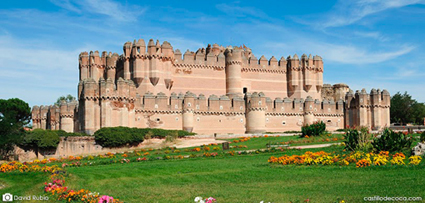
Castillo de Coca
This is one of the most spectacular castles in Spain, for many reasons. Constructed in the 5th century, it is one of the best examples of Spanish Gothic-Mudejar architecture and it is built on a meander of the Voltoya River.
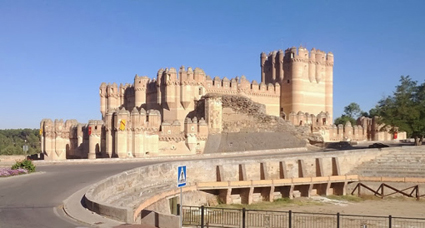
The Castle over the Voltoya river
This castle is a National Historic Monument and has a spectacular defensive system, including a gate.
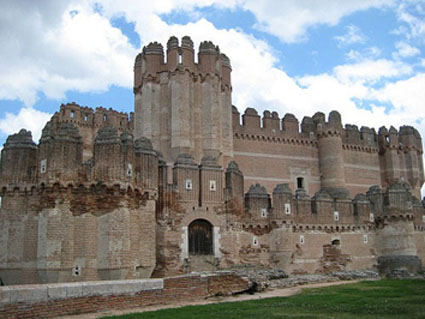
The castle with a gate
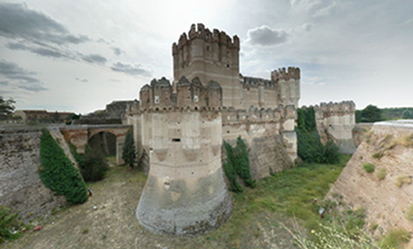
A moat where crocodiles lived
If you go to this castle, you have to see the "Torre del Homenaje” (The "Tower of the Homage”) and the precious Gothic rib vault with geometric mosaics from the Weapons Room.
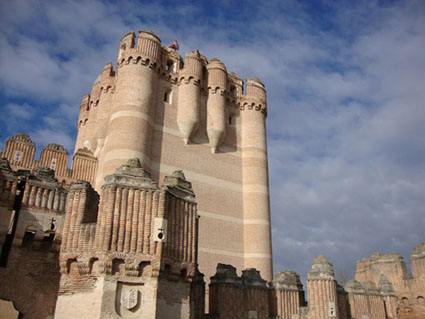
Tower of the Homage
This castle was in ruins until the beginning of the 20th century; but now, it is restored. Now it is owned by La Casa de Alba --which has been ceded to the Ministry of Agriculture, until 2054--.
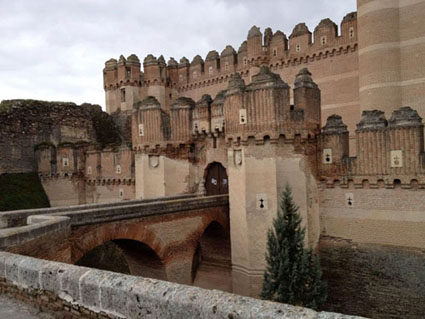
The bridge of the Castillo de Coca
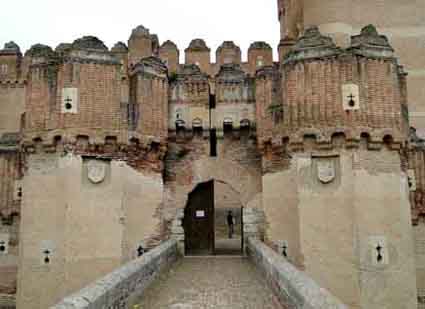
The main door
Another wonder, that we can visit in Spain, is the "Castillo de Butrón".

The Entrance to the Castillo de Butron
This Castle is of medieval origin. After several centuries of fighting between sides, it was abandoned, at the beginning of the sixteenth century, until, at the end of the nineteenth century, it was restored by the architect Mr. Francisco de Cubas and Gonzalez Montes (Marquis of Cubas), following the prevailing criteria, in that epoch, in the main castles of Europe and acquiring the current form.
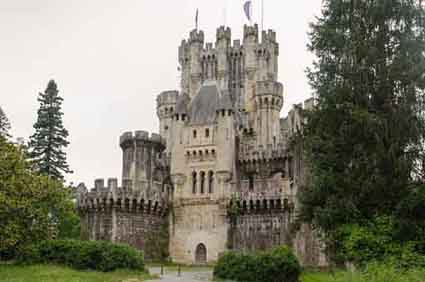
Castillo de Butrón
This fantasy of towers, turrets, battlements and decorations took, as a basis, the house-tower of the family Butrón, to turn it into a Bavarian-style castle, in Gatika, Vizcaya, 19 kilometres from Bilbao.
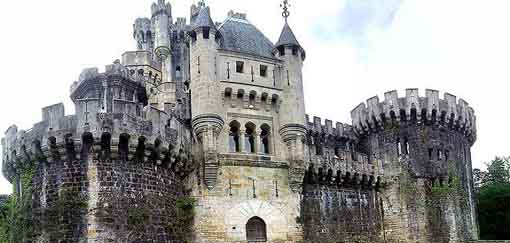
The castle with towers, turrets and battlements
The fortress is located in a privileged environment of great natural wealth and its walls, of more than 4 metres, house several halls, the old chapel, a large hall of 200 square metres, the typical courtyard, a library and a dungeon.
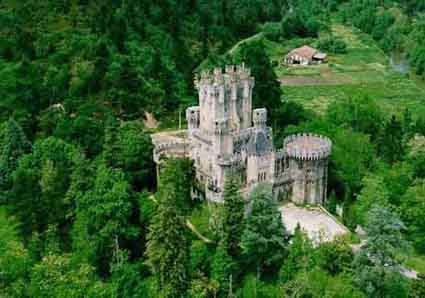
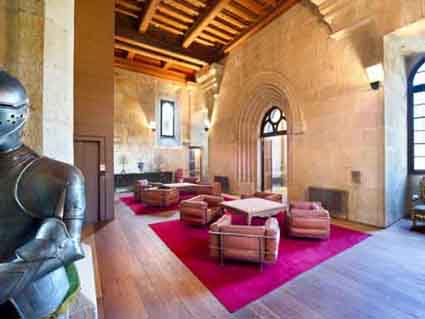
A large hall
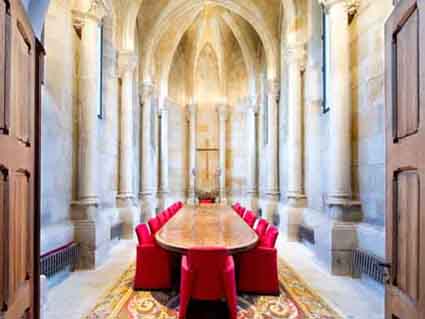
The old sanctuary
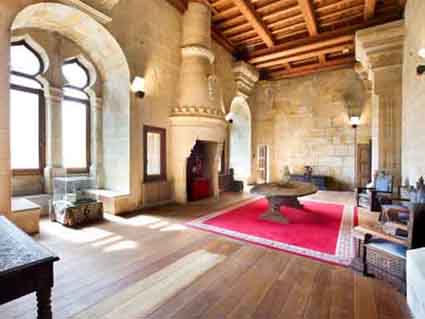
The fireplace hall
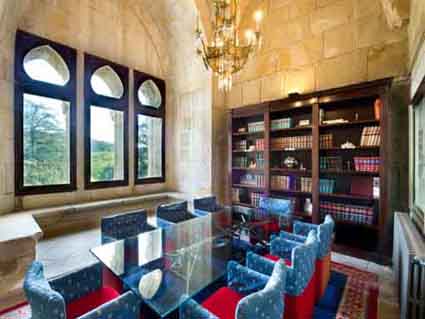
The library
For years, it was used as a hotel establishment, with medieval shows, but in 2014 it was closed and put up for sale –for 3,5 millions of Euro--.
The “Templar Castle of Ponferrada” is another fantastic fortress, among those that dot our country. It is in the region of El Bierzo (Ponferrada, León, Castilla y Leon), on a hill at the confluence of the Boeza and Sil rivers.
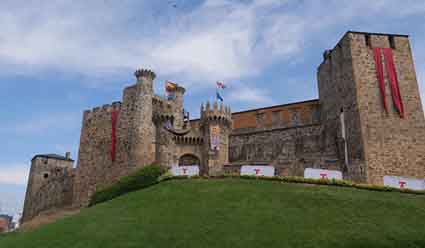
The Templar Castle of Ponferrada
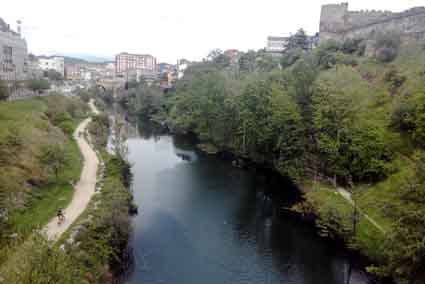
The Sil river among Ponferrada and its Castle
Although its origins go back to an ancient Celtic fort, the Templars were who gave it fame and name. When the Order of the Temple was dissolved, in the fourteenth century, the castle passed into the hands of the Counts of Lemos. This fortress full of beautiful corners is the result of centuries of reforms and extensions. Do not miss its courtyard, the remains of the barbican, part of the walk of rounds or the main gate with its two fortified towers.
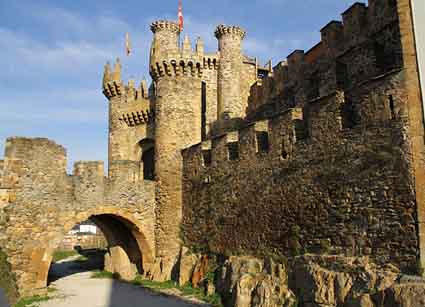
Another view of the castle
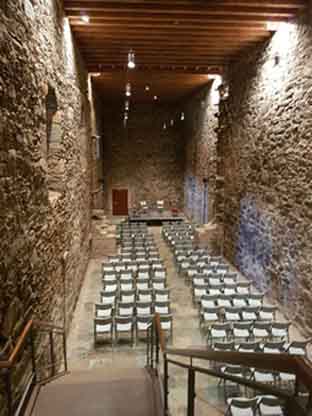
Concert hall

The library
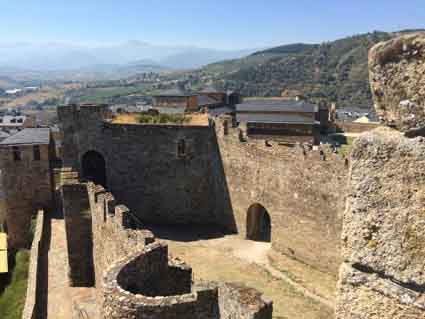
The courtyard
In the background, you can see some barbicans for cannons in a wall:
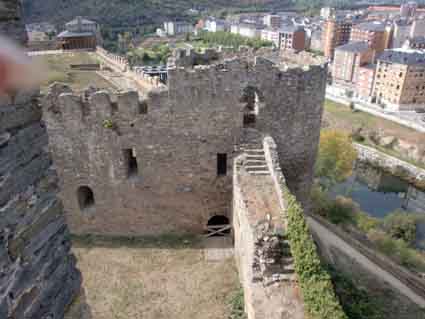
The barbicans
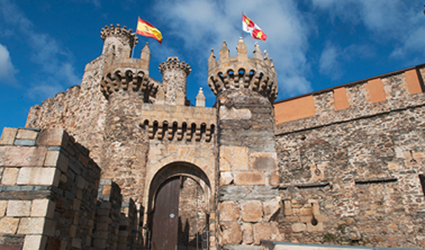
The main gate with the two fortified towers
Unfortunately, in the nineteenth and early twentieth century, it was lost a lot when the locals used it as a quarry, walls were demolished to build a soccer field and some interior rooms were even blown up. In 1923, it was declared a National Monument, thus stopping the deterioration and propitiating its recovery.
Another wonderful castle is the "Castillo de Loarre", in Huesca (Northeast of Spain). Its silhouette is dramatically outlined against the landscape and behind it is surrounded by a small leafy forest. The Castle Abbey of Loarre is a Romanesque castle and is situated on a promontory of limestone rock. It is from the eleventh century, but its state of preservation is excellent and perhaps that is why it was starring in the movie "The Kingdom of Heaven", by Ridley Scott, with Liam Neeson and Jeremy Irons.
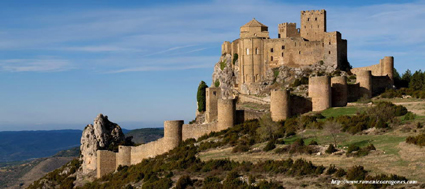
Castillo de Loarre
The fortress is surrounded by a wall of 172 metres of perimeter.
This is the oldest castle in Spain. And it is considered the best preserved fortress in Europe.
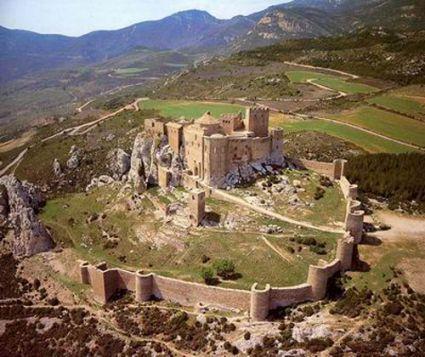
The wall of the castle
When you cross the wonderful Romanesque door, to enter the church of San Pedro, you can enjoy the beautiful decorated capitals.
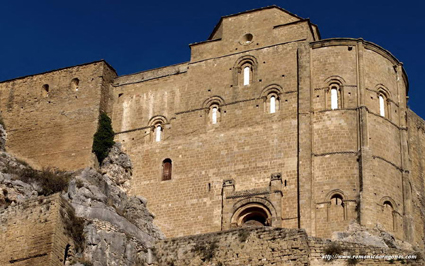
The Church of San Pedro
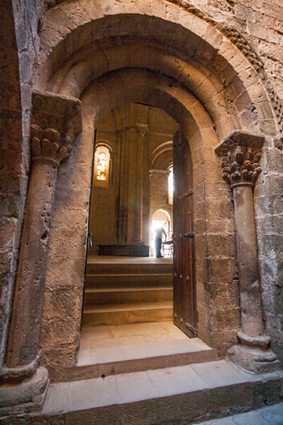
The Romanesque door of the church of San Pedro
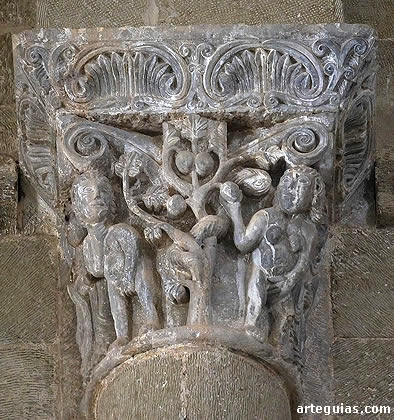
A capital inside the church
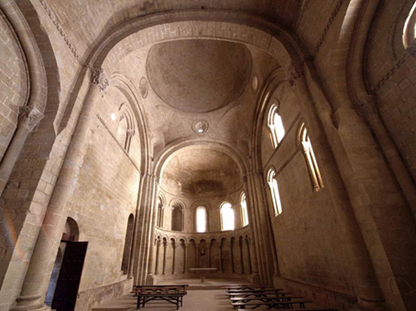
The Chapel of the church
The Belmonte Castle, surrounded by wheat fields and with the blue sky as a backdrop, is one of the most unique and best preserved fortresses in Spain.

Castillo de Belmonte
It rises on a hill to the outskirts of the homonymous village and is a National Monument.
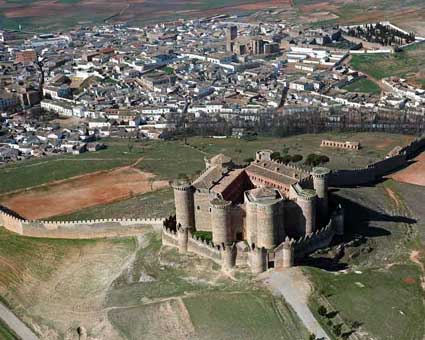
Castillo de Belmonte and Belmonte village
Its external appearance is almost the same as it was at the time of its construction, in the fifteenth century, by order of the first Marquis of Villena. It is a palace fortress that command you, at first sight, and that, like almost all, was abandoned for centuries until, in the nineteenth century, the Empress Eugenia de Montijo returned its original splendor.
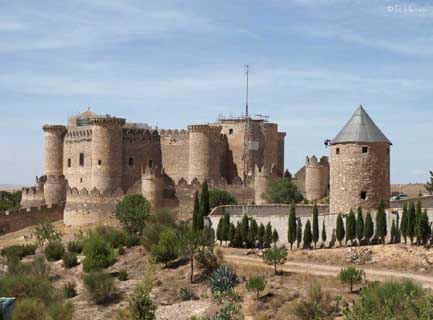
Another angle of the Castle
Today it is still inhabited and you can visit it.
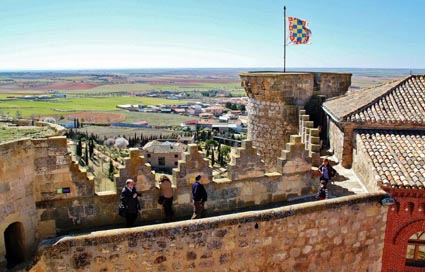
A view from the castle
Also you can see the courtyard inside the castle.
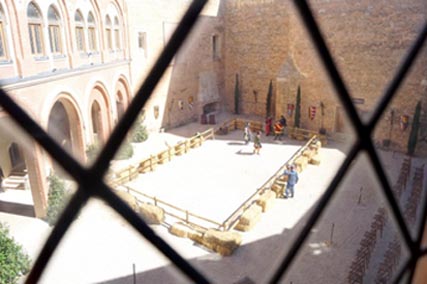
The courtyard of the castle
Every year, in August and outside the castle, the International Medieval Combat Tournament, called "HMB Europe Open Challenge of Belmonte", is held.
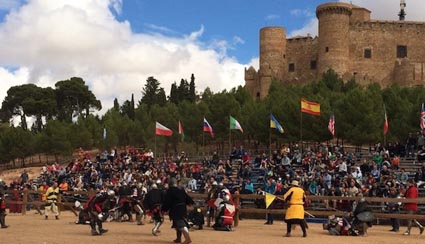
The International Medieval Combat Tournament
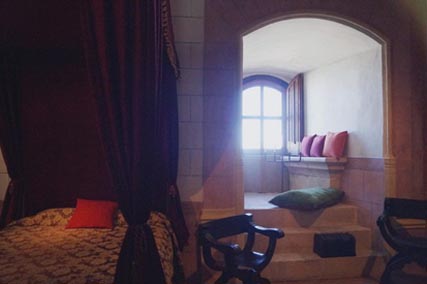
A bedroom inside the Castle
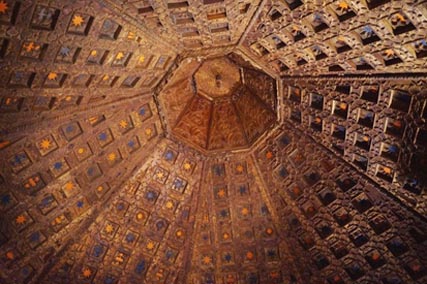
A dome inside the castle
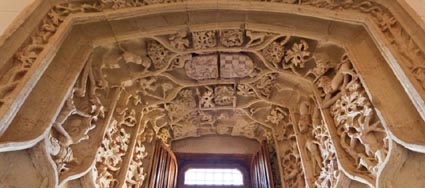
Another roof inside the castle
Now, I am going to talk to you about other fine castle: “The Castle of Almodóvar del Rio”, in Córdoba (south of Spain).
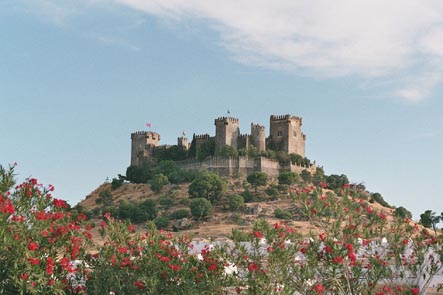
Castle of Almodovar del Rio
At the top of a hill, with the village of Almodóvar del Río at the hillside, this fortress is seen from a distance and wonder even more as you get closer to its walls.
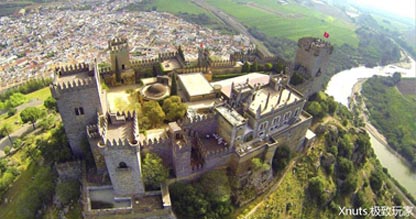
Castle and village of Almodovar del Rio
Its origins go back to the Muslim occupation, in the 8th century, although remains of a Roman fort have been found, in that place.
During the Middle Ages it was enlarged and reformed, to give it the solemn aspect it presents today.
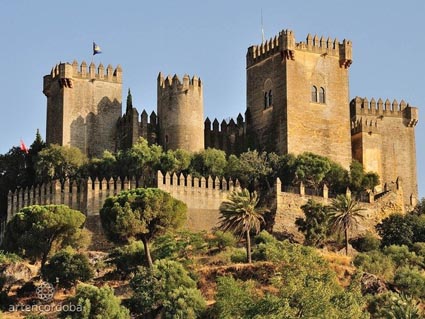
The Castle of Almodóvar del Río is a prodigious place, with its towers, its battlements and its courtyard.
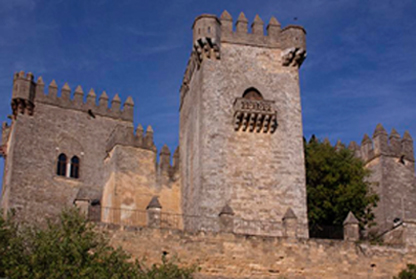
Towers and battlements of the castle of Almodovar del Rio
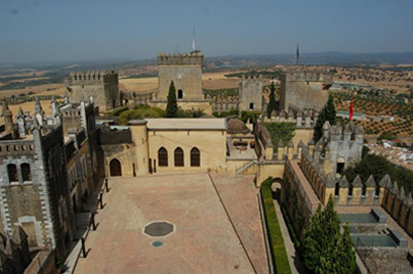
The Courtyard of the Castle of Almodovar del Rio
Fortunately, at the beginning of the 20th century, its owner (the Count of Torralva) saved it from ruin and restored it. Today, it is one of the best preserved castles in Spain. They do guided, theatrical visits and night visits, that are called "The black moon".
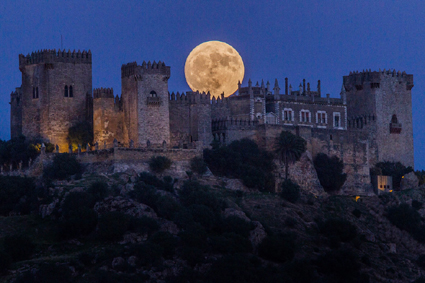
The Black Moon of the Castle of Almodovar del Rio
A spectacular castle is the "Alcázar de Segovia". It is said that Walt Disney was inspired by the Alcázar de Segovia for the castle of “Cinderella” and we are able to believe it.
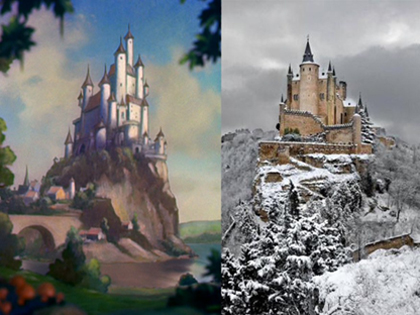
The Castle of Cinderella and the Alcazar de Segovia
This monument of conical towers, that dominates the landscape from a hill, among two rivers (Eresma and Clamores) is certainly a story.
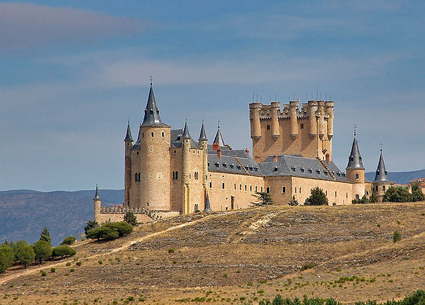
The castle on a hill
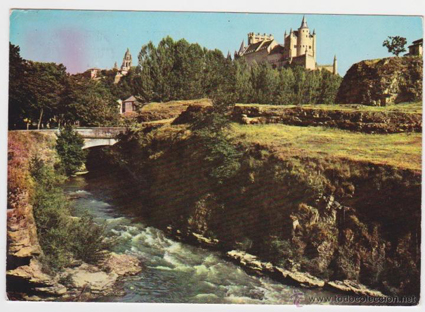
Eresma river

The riverbed Clamores below
It was built in 1122, on a Spanish-Arab fortress, and the King Alfonso VIII resided here. Over the centuries, it was restored and expanded several times, and its current profile is thanks to Felipe II.
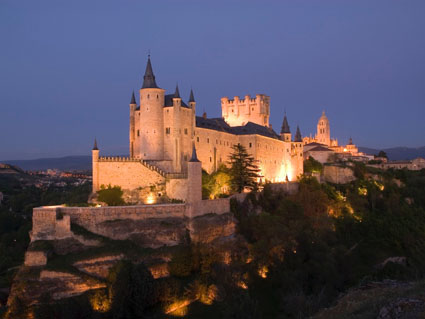
The one, that was one of the most sumptuous palaces-castle of medieval Spain, is today a Historical Artistic Monument, that tells the history through its halls and towers. The Thrones Room and the Galera Room are very famous.
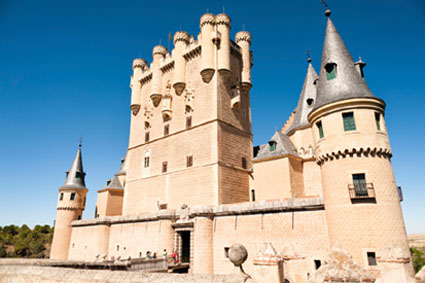
The entrance to the castle
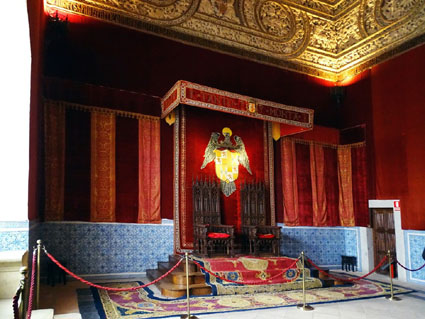
The Thrones Room
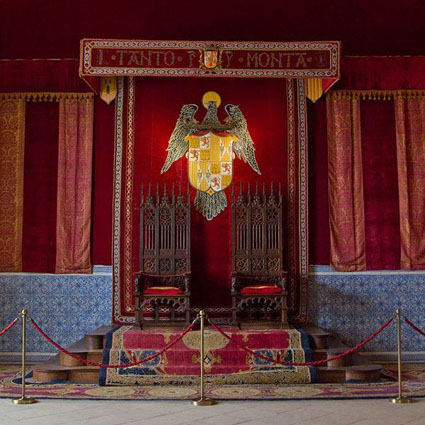
Thrones of the Catholic Kings and their coat of arms
You can see the wonderful Cathedral from the Alcázar.
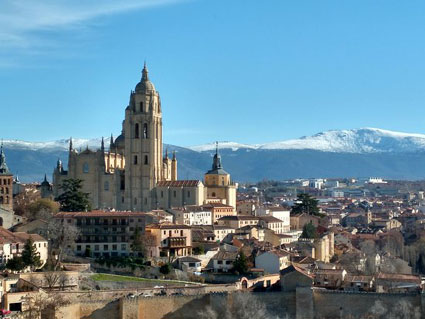
The Cathedral from the Alcazar
Here, I am going to show you another nice Castle. This fortress is known as the Royal Palace of Olite.
The Royal Palace of the Kings of Navarre, in Olite (this is its full name), is a fortress that was built between the 13th and 14th centuries, as the seat of the Court of the Kingdom of Navarre. And it is close to the village of Olite.
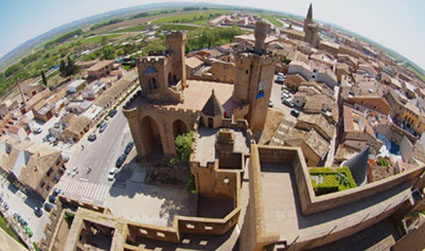
The Castle Royal Palace and the village of Olite
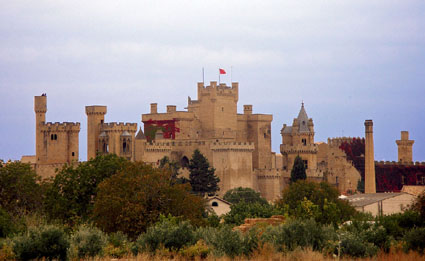
The Royal Palace of Olite close up
This palace is a fascinating set of rooms, gardens, pits and noble dependencies, that live in the shadow of legend towers and that allow to understand why it was considered one of the most beautiful, in Europe, in its epoch.
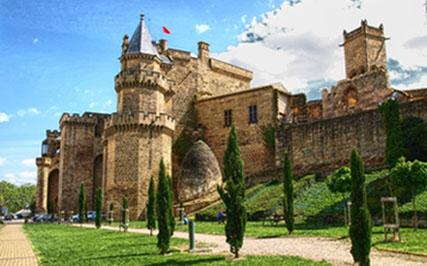
Gardens outside of the Royal Palace of Olite

The Queen´s Garden in the Palace

Another angle of the Queen´s Colonnade
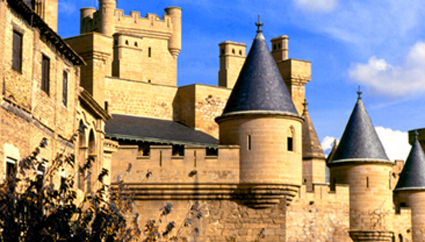
Towers of the Royal Palace
It was a victim of time and a fire, during the War of Independence, that worsened the process of deterioration. In 1937, it began to be restored to give it back the past luster and despite the fact, that it has been lost a lot today, it is possible to sleep within its walls, in a Parador of Tourism. If you want to go there, you can call to the telephone number: (+34) 976 301 523.

The National Parador of Olite
Inside the Palace, you must visit the King´s Colonnade.

The King´s Colonnade
From this Colonnade, you can see the Patio of the Mulberry.
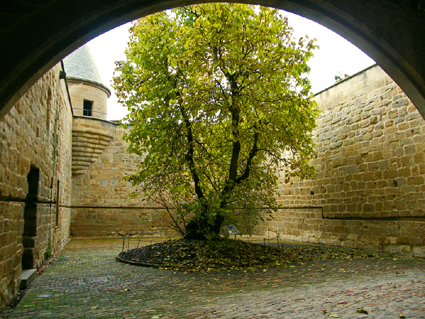
The Patio of the Mulberry
The next castle --among the most beautiful in Spain-- is the "Castle of Cardona", in Barcelona (Catalonia).
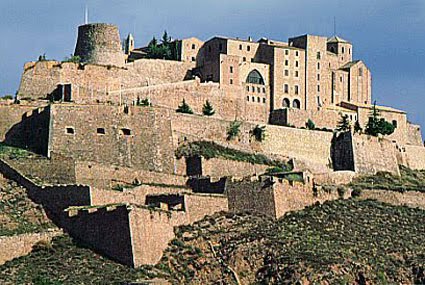
Castle of Cardona
In the heart of Catalonia rises the most important medieval fortress of the Community. This large mass of stone buildings crowns a hill, from which you can see an special landscape.
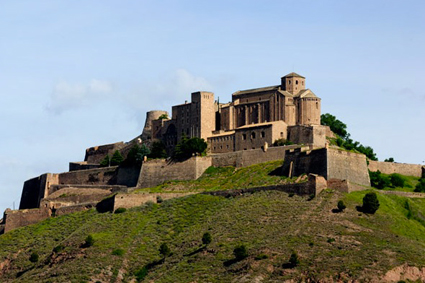
The Castle of Cardona on a hill
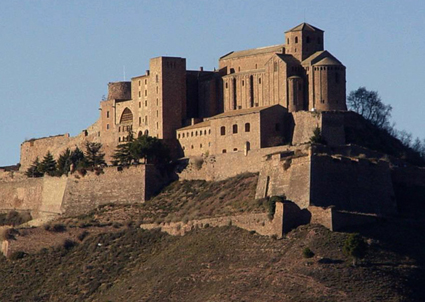
The Castle close up
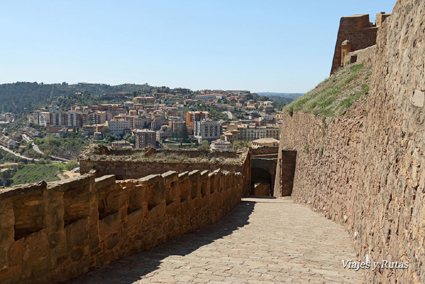
The village of Cardona from its Castle
This Castle was built in the year 886 and it is Romanesque and Gothic, although it lived its maximum splendor during the fifteenth century, under the rule of the Dukes of Cardona, the most important family of the Crown of Aragon.
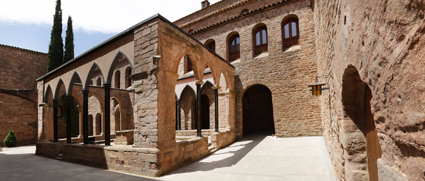
The Cloisters of the Castle
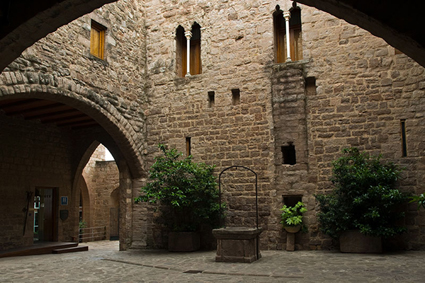
The Weapons Courtyard of the Castle
A part of the enclosure harbours a National Tourism Parador and the other can be visited.
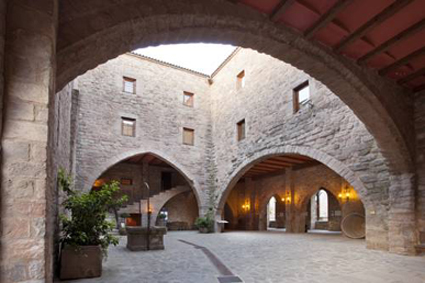
The interior courtyard of the National Parador
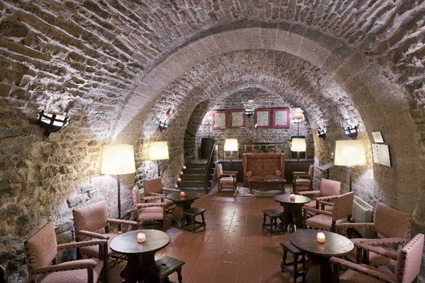
A sitting room of the Parador

A bedroom in the National Parador of Cardona
Among its jewels are the majestic Romanesque church of San Vicente ........
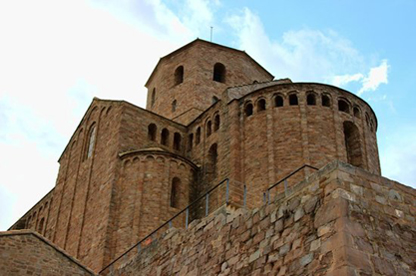
The Collegiate church of San Vicente
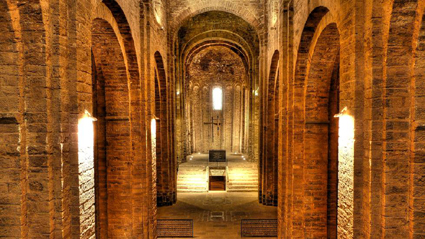
Inside the Collegiate church of San Vicente
……..and the tower of the Minyona, from the 11th century.
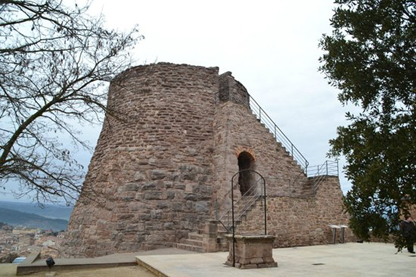
The Tower of the Minyona
Have you ever seen a castle shaped like a ship?. Well, if this is not the case, visit the village of Peñafiel, in Valladolid (195 km from the north west of Madrid, on the "A1" highway).
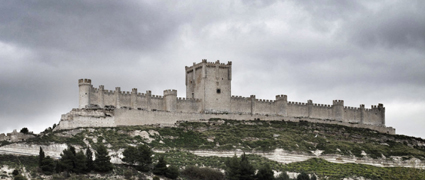
The Castle of Peñafiel
It is a clear stone fortress, that stands on a narrow and long hill.
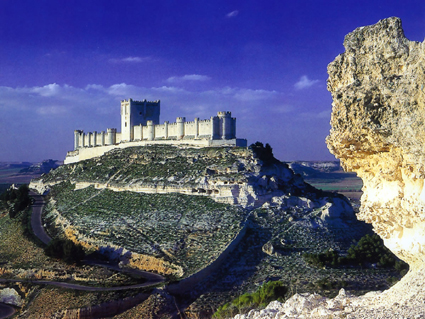
The Castle on a hill
National Monument since 1917, it was built in the tenth century, when he was king of León Ramiro II, although it was the Infant Mr. Juan Manuel, who left it as you can see it. With a plant 35 metres wide by 210 meters long, the Peñafiel castle is a prodigy of medieval architecture.
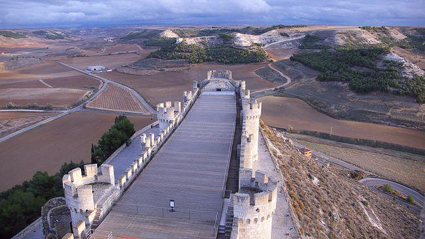
210 metres long and 35 mts wide
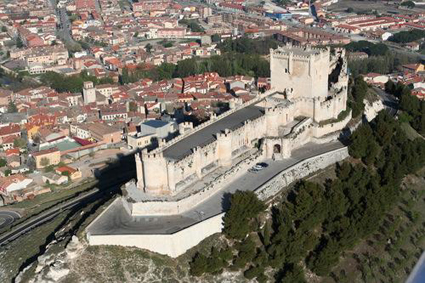
Castle and village of Peñafiel
Its walls are very interesting,

The walls of the Castle
But the Tower of the Homage is the jewel in the crown.
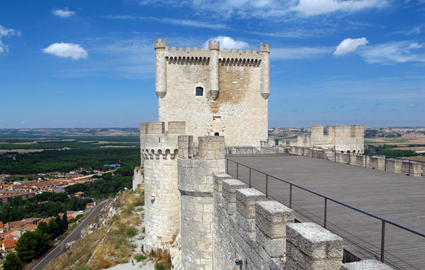
The Tower of the Homage
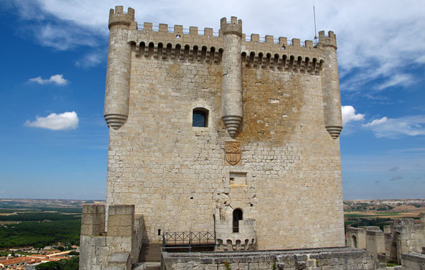
The Tower of the Homage close up
In one of its rooms, you can see the Provincial Wine Museum.
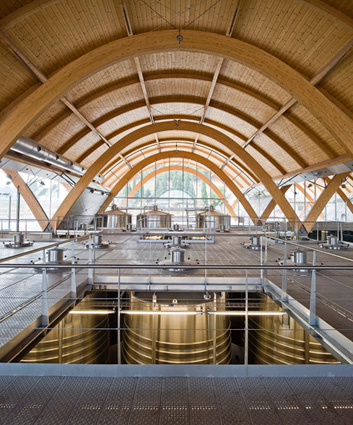
Provincial Wine Museum
The “new castle of Manzanares el Real” is also known as “of the Mendoza”, since it was the residential palace of this noble house for centuries.
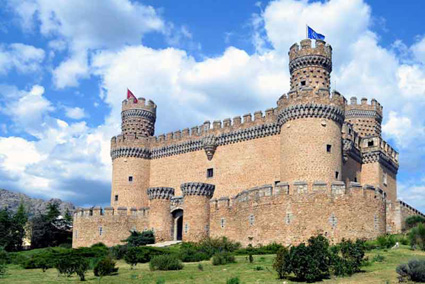
New Castle of Manzanares El Real
It is a 15th-century palace-fortress located in the municipality of Manzanares el Real (province of Madrid), next to the Santillana reservoir and at the foot of the Sierra of Guadarrama.
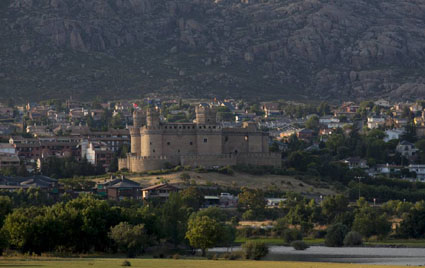
Manzanares El Real and its Castle
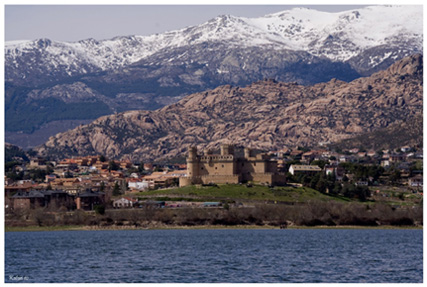
Reservoir of Santillana with the Castle of Manzanares and the Sierra of Guadarrama on the background
The castle was built on a Romanesque-Mudejar hermitage and is a real jewel. It is quadrangular and has four towers (three circular and the one of the homage, which is octagonal), battlements, machicolations and a barbican --full of arrowholes-- surrounds it.
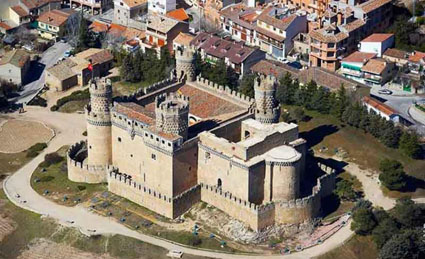
The floor of the new Castle of Manzanares el Real
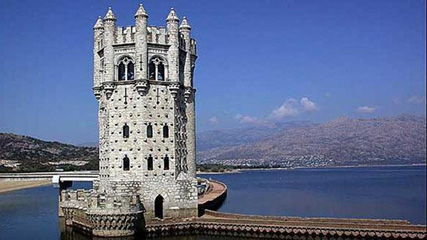
One Tower and the reservoir
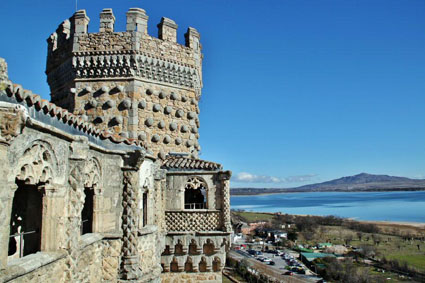
The Tower of the Homage
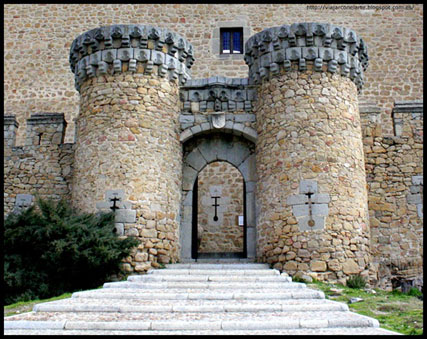
Access to the Barbican
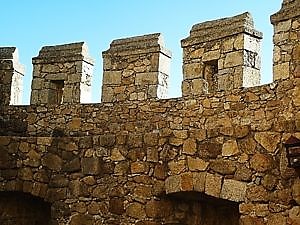
Arrow-holes
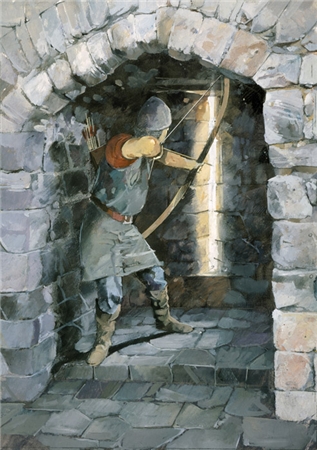
An Archer shooting through an arrow-hole
Its inner courtyard is arcaded and it is a wonder, while the Gothic gallery, on the first floor, is one of the most beautiful, that you can see.
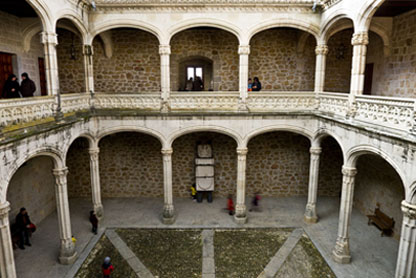
The inner Courtyard
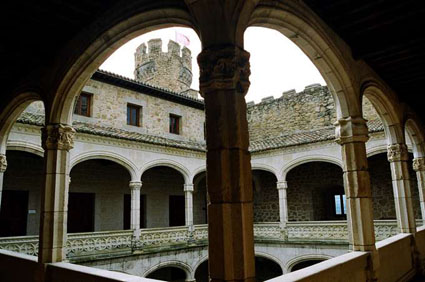
Gothic Gallery
Perched on top of the beautiful Andalusian village of Velez-Blanco (Almería, South east of Spain), this castle stands on the remains of an old Islamic alcazaba, located on this same hill, that controls the village.
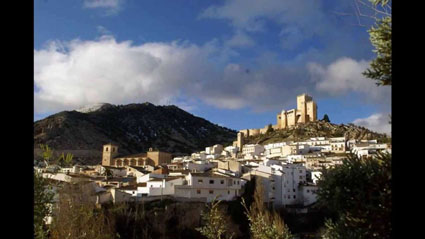
Village of Velez Blanco and its Castle above
This Castle was owned by Pedro Fajardo y Chacón, who was named Marquis of Vélez, by the Catholic Monarchs, and, although it is still impressive, it could be much more had it not been for the looting and abandonment, that it suffered in the 19th and 20th centuries.
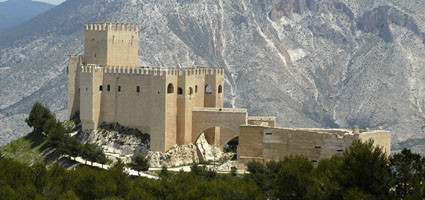
Castle of Velez Blanco
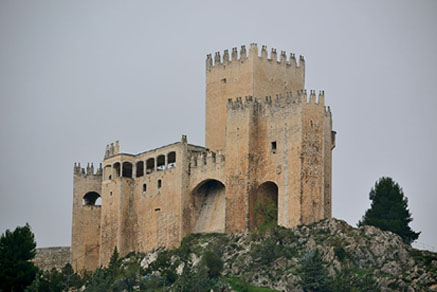
The Castle close up
In this castle they stand out:
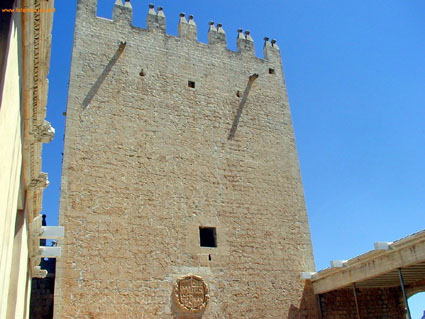
The Tower of the Homage
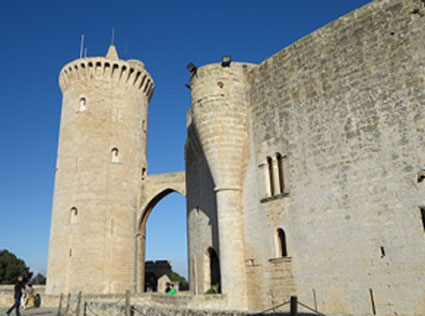
The Albarrana Tower
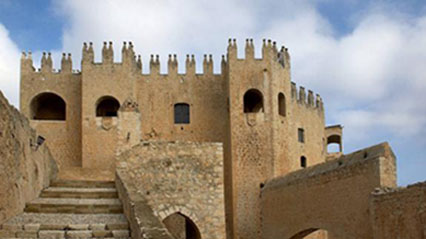
The Windows
Its beautiful Courtyard of Honour was a masterpiece of the Spanish Renaissance, that was sold to an American millionaire, who took it to New York and where, today, it can be seen inside the MET Museum.
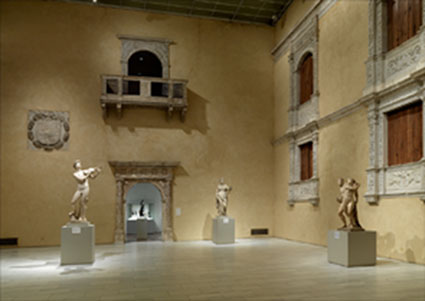
Courtyard of Honour
 a 15 cm.png)
Balcony made of marble from Macael (Almería)

Courtyard of Honour in the MET Museum
Inside the Castle, there is a room where, every year, the Festival of Renaissance and Baroque Music is celebrated.
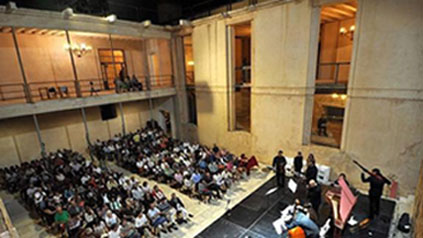
Festival of Renaissance and Baroque Music
The precious wooden friezes, that represented "the twelve works of Hercules" and "the triumphs of Caesar", were also sold and today they are in the Museum of Decorative Arts of Paris.
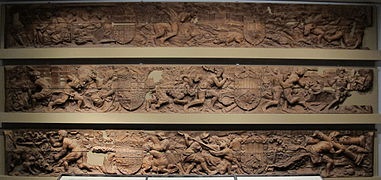
Wooden friezes with 12 works by Hercules and Triumphs of Cesar
You can also see several shields inside the Castle, such as this one:
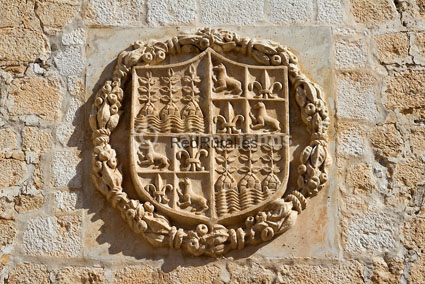
A shield inside the Castle
Another beautiful castle is the "Castle of La Mota", which is next to the village of Medina del Campo, in Valladolid (Northwest of Madrid).
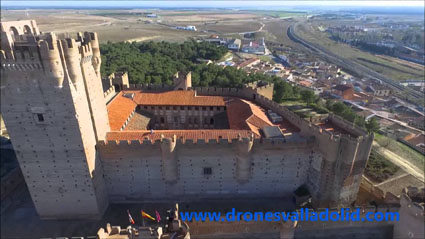
Castle of La Mota and the village of Medina del Campo behind
This castle is on an elevation of the land (hence its name), from which it controls the entire region.
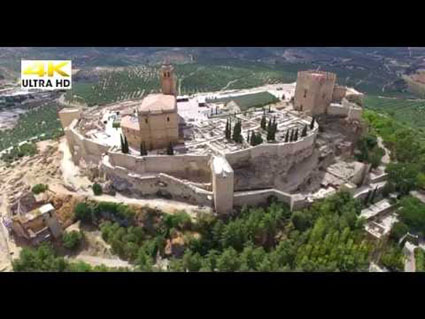
The Castle of La Mota on a hill
The walled enclosure is impressive, in the typical reddish brick of the area, so much so that it is not surprising that it was declared a Cultural Interest Site, in 1904.
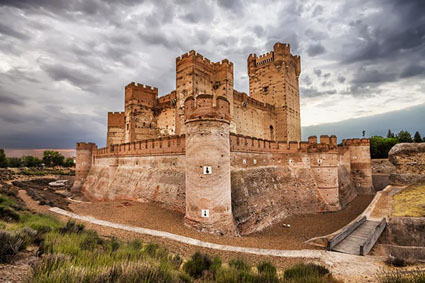
Another angle of the Castle
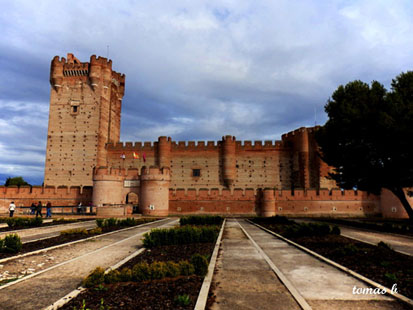
Main facade of the Castle and its entrance
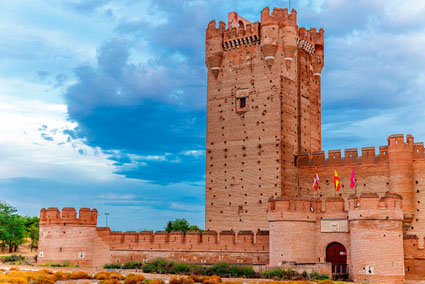
The Castle made of red brick
Its story has been turbulent and between its walls and high towers have been imprisoned characters like Cesar Borgia, who escaped by hanging from the Tower of Homage using ropes.
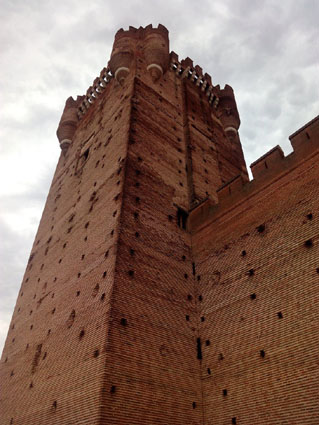
Tower of the Homage
This fortress has survived wars and conflicts, which have left scars that can still be seen on its walls today. You can visit, so do not miss its fabulous parade ground, nor the chapel in Moorish-Romanesque style.
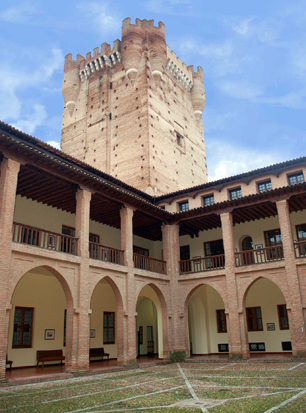
The Parade Ground of the Castle and Tower of the Homage
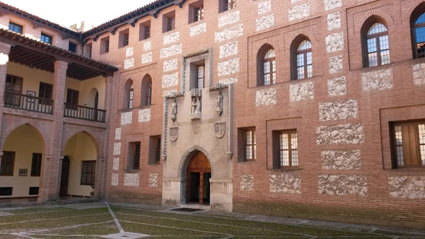
Parade Ground and entrance to the chapel of the Castle
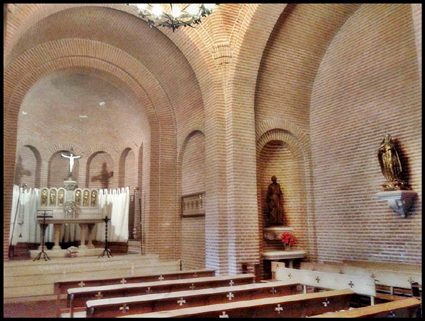
Chapel of the Castle
Pay attention to this Castle……Circular, with four terraced towers and privileged views of the city of Palma, the port, the Tramontana mountains and the Pla de Mallorca, the Bellver Castle lives up to its name (in Old Catalan it means "beautiful view"). It is one of the few circular fortresses in Europe and the oldest of all, since it was built in Mallorcan Gothic style, at the beginning of the 14th century, by order of Jaime II.
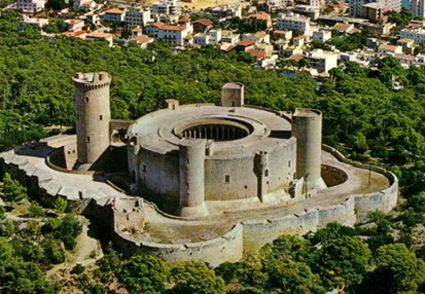
Circular floor of the Castle of Bellver
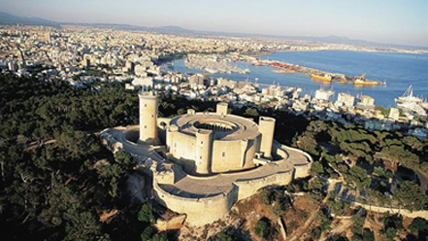
The Castle and Palma on background
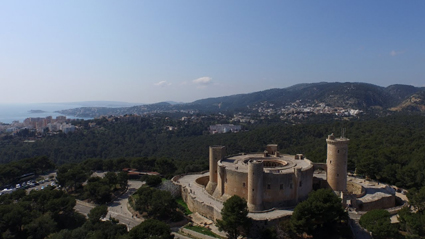
The Castle and Sierra of Tramontana
A moat surrounds it and the Tower of the Homage, the largest, is a fabulous viewpoint.
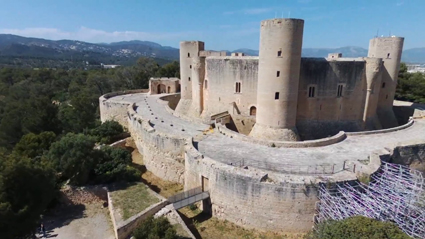
The moat from afar
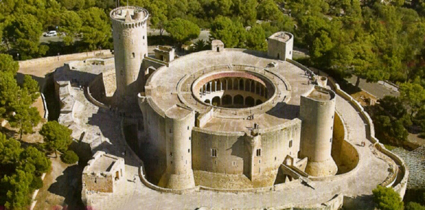
The Castle with moat from above
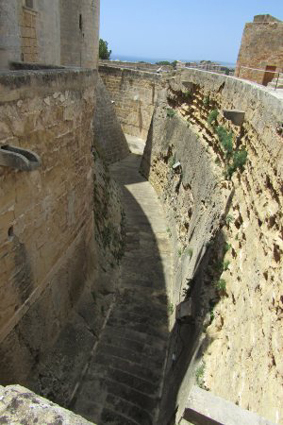
The moat of the Castle
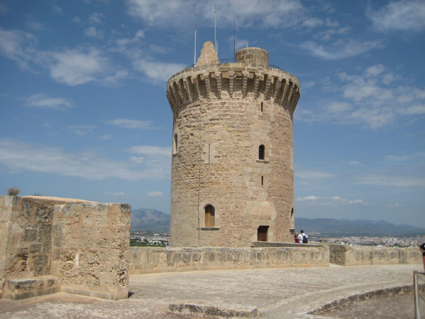
The Tower of the Homage
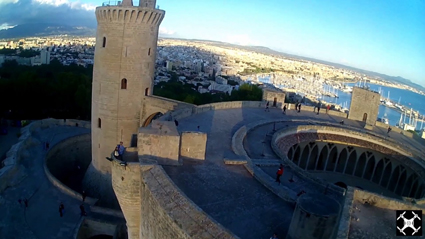
A view of Palma from beside the Tower of the Homage
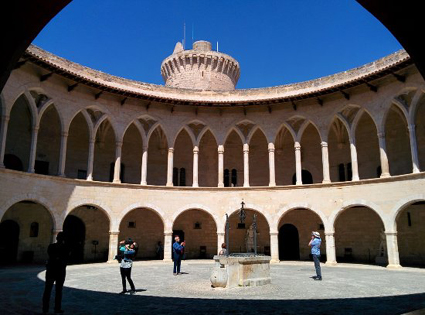
The Courtyard of the Castle
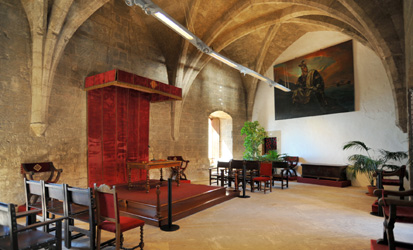
The Room of the Throne inside the Castle
Although the Alhambra is not a castle to use, this rich palatial and fortress complex is simply so spectacular that it could not be out off this list.
Located at the top of Granada, it was the seat of the monarchy and the court of the Nazari Kingdom and is one of the peaks of Andalusian art, as well as one of the most visited monuments in Spain.
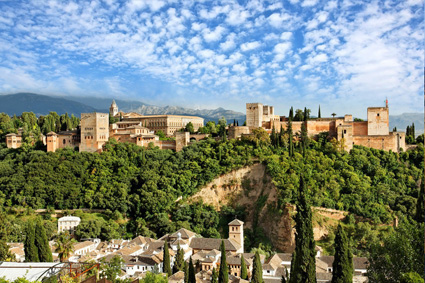
La Alhambra
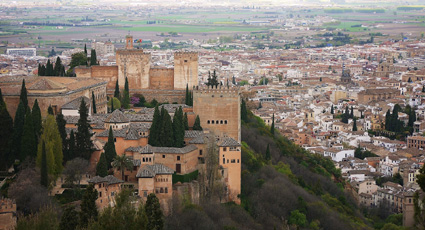
La Alhambra and Granada on its right side
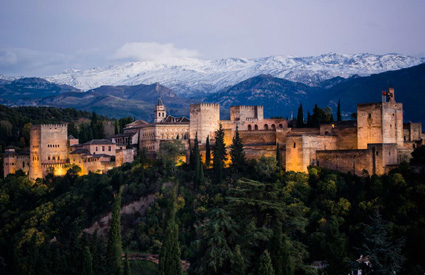
The "red fortress" is a great walled city, in which time seems to have stopped forever.
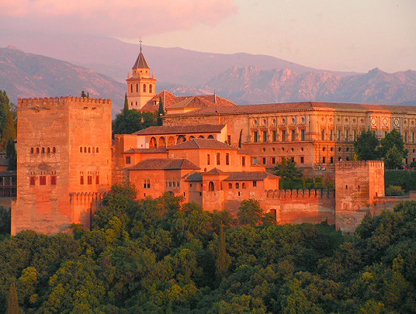
The Red Fortress
Among richly decorated rooms, rooms with fountains, the fabulous “Patio de los leones”, paradisiacal gardens and much more it will seem that you are not on earth. The Nasrid Palaces are the true jewel in the crown.
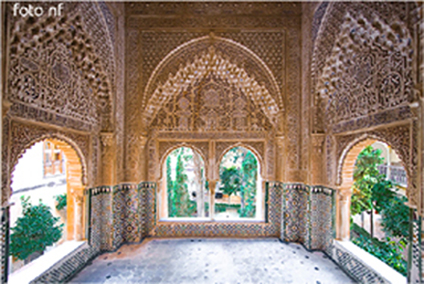
A richly room decorated
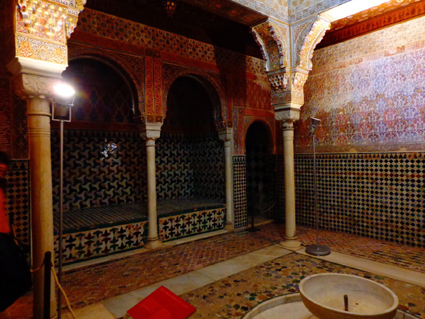
A room with a fountain
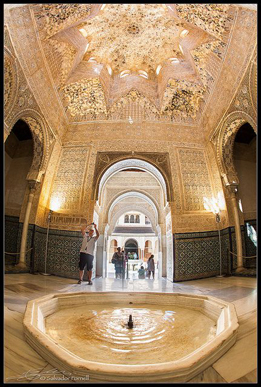
Another indoor fountain
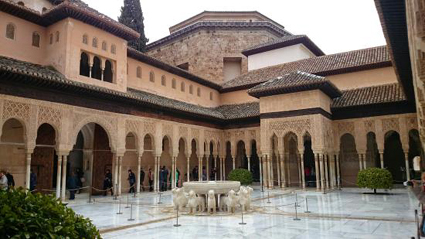
Patio de los Leones
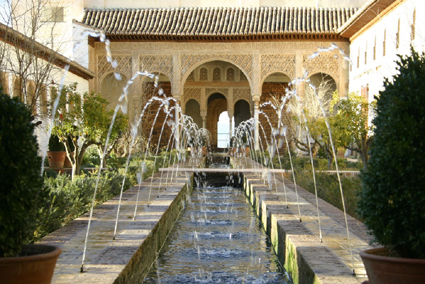
Another gardens in La Alhambra
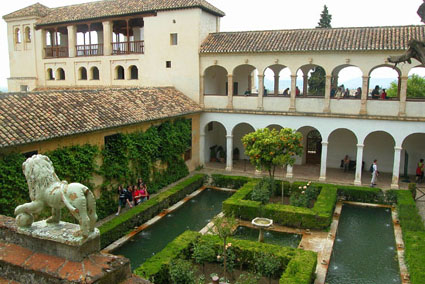
Patio de la Sultana in La Alhambra
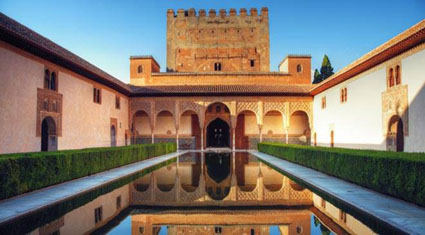
Palacio de Comares in La Alhambra
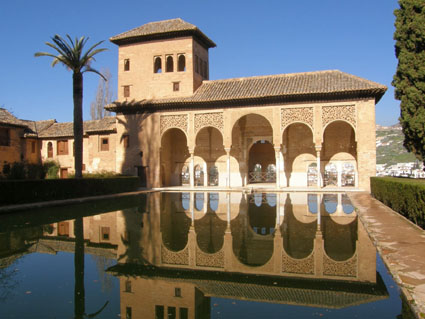
Palace El Partal
But, if you go to Granada, do not forget to visit the Generalife (a part of the complex of La Alhambra).
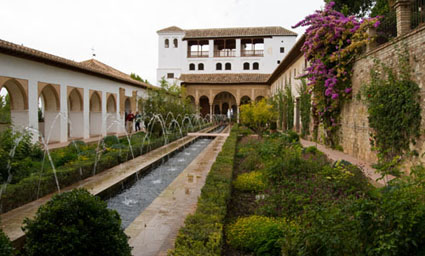
Palace and gardens of the Generalife
Well, I hope that you will like this article and hope that you can go to Granada and enjoy this wonderful city.
Until my next post, kind regards,
Luis.
Sponsored by Costaluz Lawyers.
Please click below:
